
|
|
|
|
 |
|
Home Site Search Contact Us Subscribe
|
|
|
|
INSIGHT: Metamorphosis and Transcending Hype: Observations from the Field
The Venice Biennale offers a message of optimism and exuberant anticipation for architecture in a post-9/11 world -- for the most part. by Margaret Helfand, FAIA September 16, 2004 An exhibition presenting thousands projects created by
hundreds of architecture studios distributed throughout tens of acres of
buildings and outdoor installations is not an easy phenomenon to experience.
Kurt W. Forster, the director of the 9th Biennale of
Architecture in Venice, attempted to order this Herculean, hyper-scale
survey of worldwide architecture by defining several axes of thought – history,
technology, and scale – under the overarching concept of “metamorphosis.” This
is no small task, but with the assistance of installation designers Asymptote
(Hani Rashid and Lise Anne Couture) and the graphic design studio Omnivore,
Forster has succeeded in delivering a message of optimism and exuberant
anticipation for architecture in a post-9/11 world. Reality is a strong theme in Venice this year, both in
Forster’s curated exhibition in the complex of abandoned 15th-19th
century shipyard mega-structures known as the Arsenale, and the nearby national
pavilions of the Giardini, home of the Venice Biennale of Art for over a
century. Perhaps it was the shock of 9/11 or perhaps the shock of the new
century that insisted that we now redefine modernity for our buildings and
cities. But rather than letting us get bogged down in self analysis about our
failing urban, suburban, and ex-urban landscape, Forster makes a convincing
case that architecture can redeem us through intelligently conceived sites and
buildings. The linear installation in the Corderie, the main exhibition
hall at the Arsenale, artfully comprises the fixed-point snapshot of each of
200 projects and the dynamic vision of space and time emblematic of our moment
in history. Text, plans, photos, and videos flank the parallel walls while
models float above enormous gondola forms positioned perpendicular to the flow
of movement, themselves morphing gently in an undulating rhythm from low to
high down the enormous length of the building. Thus, the extended gallery of
the Corderie offers a physical experience of the contrast between a fixed
perspective and a dynamic vision of space as the true substance of
architecture. The exquisite materiality of the many models provides a lush
counterpoint to the detailed information on the descriptive panels lining the
walls, and offers a sensual shorthand to suggest a critical component of the
perception of the buildings themselves. The linear experience of this installation is segmented,
much like the structure of a symphony, into five themes. In TRANSFORMATIONS,
existing buildings and sites are explored through analytic exercises, often
through the use of computer technology, such as Dagmar Richter’s transformation
of an elementary concept of building, Le Corbusier’s Casa Dom-Ino, or Michele
Saee’s rewrapping of the Drugstore in Paris. The next section, TOPOGRAPHY, embraces both computer
generated topological generation of form and large scale projects in the
landscape that create new landforms, such as the Paul Klee Museum in Berne,
Switzerland, that Renzo Piano has conceived as a series of undulating hill
tops, or Peter Eisenman’s Ciudad de Cultura in Santiago de Compostela, Spain.
The use of organic or bio-morphic forms, enabled by computer technology in
design and fabrication, is ubiquitous in all components of the exhibition.
Employing new concepts of continuous structures, such as modulated space frames
and continuous bent or curved surfaces, these projects explode the boundaries
of traditional Vitruvian mechanics of column-and-beam thinking. Following the exploration of Topography, SURFACES digs
deeper into the current preoccupation with building skins. Closely related to
the new experiments with continuous structures, these projects employ metal,
glass, and building technology to dramatic effect. In ATMOSPHERE, the time
dimension and link to natural phenomena are introduced. These projects, such as
Alsop Architects’ Liverpool housing and TEN Arquitectos’ Habita hotel, propose
that buildings can be seen as living organisms rather than as fixed objects, as
their exteriors respond to environmental conditions and natural light. In the final section, HYPER-PROJECTS, the question of
community is introduced. This is the least convincing segment of the
exhibition, perhaps because Forster’s obsession with the formal aspects of
architecture leaves him with the myopic view that urban issues can be addressed
through physical form alone. While most projects embody mixed-use programs – a
fundamental requirement in urban developments for the 21st century –
he is unable to focus on the experiential aspects of pedestrian circulation,
the connections between these new mega-developments, and existing urban fabric
and massing concepts responsive to the human scale. Form-making is not the
answer here, although once the urban issues are successfully addressed, all
other elements he proposes for the new architecture would be welcome components
of the design solution. Two projects from the Olympic Village competition for
the NYC 2012 Olympic bid in New York on a waterfront site in Queens (Morphosis
and HLT Henning Larsens Tegnestue) illustrate this challenge well, since even
Morphosis’s winning solution leaves many unanswered questions about scale, and the
relationship of the project to the surrounding community and the context of New
York City. The national pavilions in the Giardini have a full spectrum
of interpretations of the “Metamorph” theme. The United States offering,
organized by Architectural Record magazine’s staff, including Editor-in
Chief Robert Ivy (Commissioner), and Clifford Pearson and Suzanne Stephens
(Co-Commissioners), at the behest of the U.S. State Department, fills the small
U.S. pavilion with visions of future directions for six different building
types. Entitled “Transcending
Type,” these installations of models and drawings are intended to provide
food for thought on the subjects of what Ivy terms “mundane or too familiar” –
and ubiquitous – architectural types. Six firms were selected to present
proposals including a PARKING GARAGE (Lewis.Tsurumaki.Lewis), a SHOPPING CENTER
(George Yu Architects), an APARTMENT TOWER (Kolatan/MacDonald Studio), a SPORTS
STADIUM (Studio/Gang/Architects), a SPIRITUAL SPACE (Predock_Frane), and a HIGHWAY
INTERCHANGE (Reiser + Umemoto). While the concept for the exhibition is ambitious – the exploration of future directions for the critical architectural challenges of our era – the exhibition as realized communicates more about the physical objects displayed rather than the ideas embodied. Other than Studio/Gang’s fold-out bleachers surrounding a roof-top baseball field in a dense high-rise context (effectively installed in the small central rotunda), and Predock_Frane’s incandescent and mesmerizing site-specific installation of suspended green and white filaments which offer no pretense of any larger reality than itself in the present moment, the viewer is left puzzling over how these proposals might actually influence the reality of the future. In some cases, insufficient narrative or descriptive drawings make even trying to understand the proposal itself difficult. Unfortunately, no introductory text is provided to help the viewer understand the background and curatorial intent. But given the nearly impossible five-month timeframe to
conceive, organize, and install the exhibition – and the equally constraining
lack of funding (the Architectural Record group, working pro-bono,
managed to raise barely sufficient funds in just those few months from commercial
vendors and several large American architectural firms), it is remarkable
indeed that the U.S. is this well represented. But this situation raises many
questions for consideration for shows that Architectural Record or other
organizations may produce for future Biennales. This bi-annual snapshot of
architecture within the national boundaries of each of the nearly 50
participating countries is a salubrious opportunity for comparison and
self-assessment, but we must seek a better structure to conceive and produce
our offering to this prestigious worldwide event. In this context, it is worth mentioning several other
national pavilions whose exhibitions succeed at both presenting reality and
inspiring the viewer with possibilities for the future. The British Pavilion,
curated by Peter Cook, provides another version of vision and reality by
showing nine projects by nine firms. Cook, better known for his witty,
bombastic, fantastical propositions, opted here to showcase work that embodies
just “good design” achieved in the real world by lesser-known firms. He also
employs a lively and memorable exhibition concept: life-size photos of the
architects welcome visitors, and wall text and other bold graphic devices
explain the ideas and create continuity among the various galleries. The Spanish Pavilion, curated and designed by Gerardo Ayala
and his firm, chose a straight-on approach of showing 28 firms, each with two
projects elegantly displayed on glass panels marching through the enfilade of
galleries. The simplicity of traditional expository text, drawings, and photos
gives a welcome sobriety and leaves the viewer with the distinct impression
that the Spanish have found that delicate balance between respect for the past
and strategic implementation of new forms, materials, and technology. An instructive example of less surpassing more, one of the
most well received efforts in this year’s Biennale is the Finnish pavilion –
one of the smallest at less than 1,000 square feet. Here, 14 projects are
presented in “From Wood to Architecture.” Through short narratives, drawings,
photographs, and models, this exquisite handful of projects executed in wood
say more than enough about the current preoccupations of Finnish architects.
With little fanfare but extraordinarily sensitive response to landscape,
climatic conditions, program, and tectonics, the architects demonstrate that
architecture need not be bombastic but can quietly lead the way to a sublime
future. The Biennale continues through November 7, 2004. Margaret
Helfand, FAIA, is founder and principal of New York City-based Helfand Architects. |
(click on pictures to enlarge) 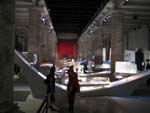 (Jon Turner) Entry to Corderie Gallery at Arsenale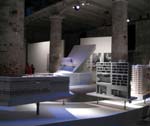 (Jon Turner) Installation view at Arsenale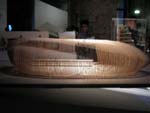 (Jon Turner) Arsenale Surfaces Section: Model for Miran Gallery, Paris, by dECOi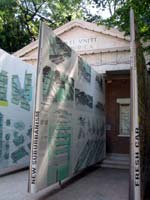 (Jon Turner) US Pavilion: Parking Garage by Lewis.Tsurumaki.Lewis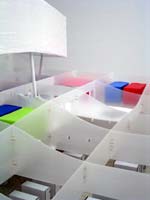 (Jon Turner) US Pavilion: Shopping Center by George Yu Architects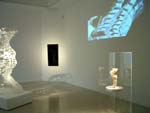 (Jon Turner) US Pavilion: Apartment Tower by Kolatan/MacDonald Studio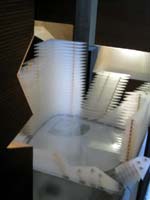 (Jon Turner) US Pavilion: Sports Stadium by Studio/Gang/Architects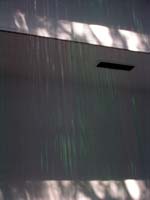 (Jon Turner) US Pavilion: Spiritual Space by Predock_Frane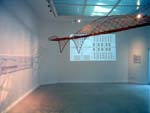 (Jon Turner) US Pavilion: Highway Interchange by Reiser + Umemoto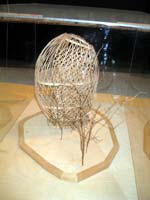 (Jon Turner) Finland Pavilion: Korkeasaari Lookout Tower, Helsinki, by Ville Hara with HUT Wood Studio |
© 2004 ArchNewsNow.com